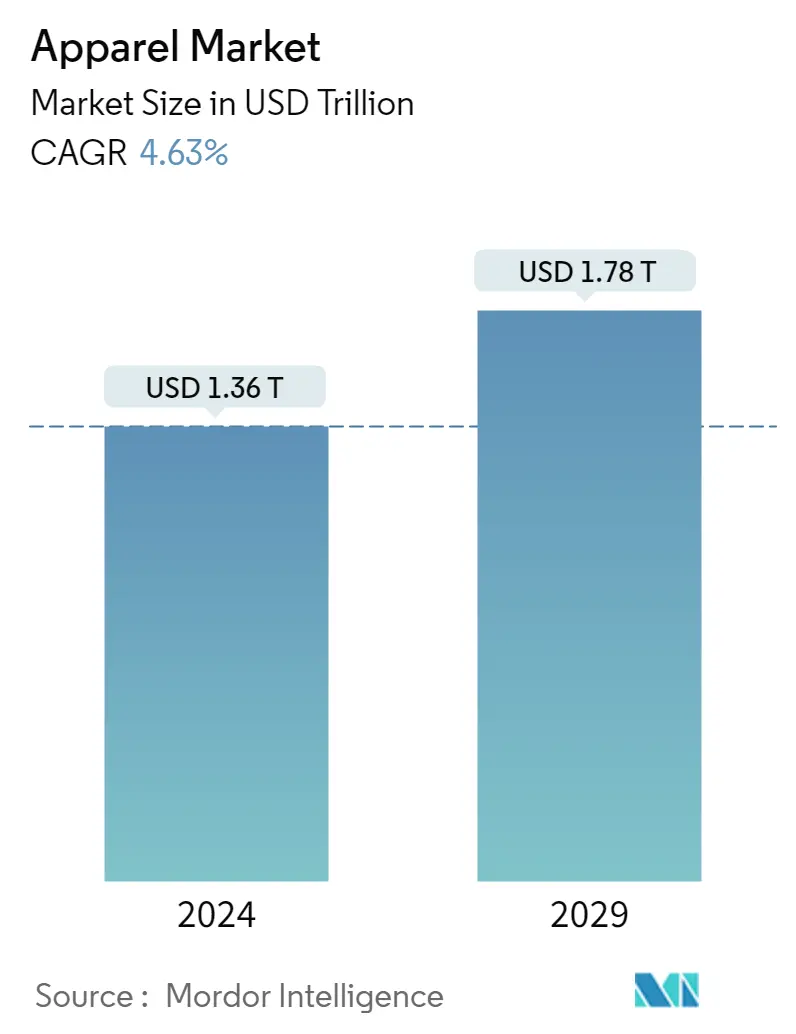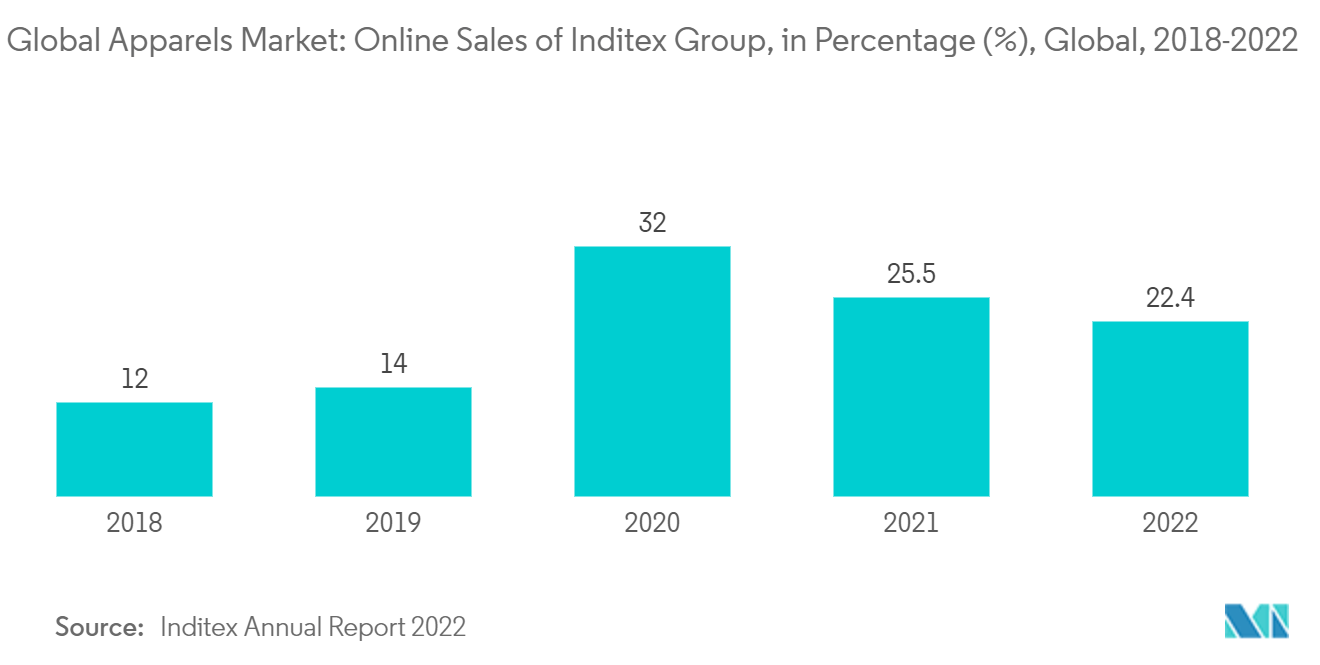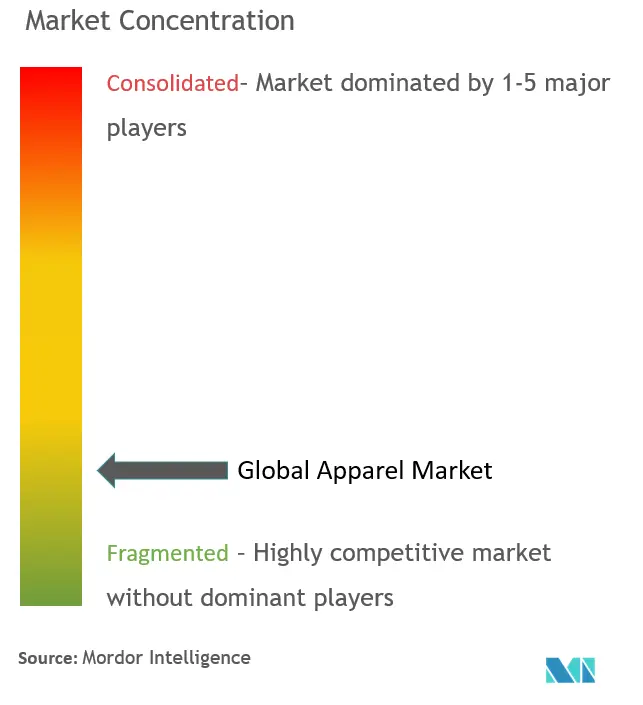Apparel Market Size

| Study Period | 2019 - 2029 |
| Market Size (2024) | USD 1.36 Trillion |
| Market Size (2029) | USD 1.78 Trillion |
| CAGR (2024 - 2029) | 4.63 % |
| Fastest Growing Market | Asia Pacific |
| Largest Market | Europe |
Major Players
*Disclaimer: Major Players sorted in no particular order |
Apparel Market Analysis
The Apparel Market size is estimated at USD 1.36 trillion in 2024, and is expected to reach USD 1.78 trillion by 2029, growing at a CAGR of 4.63% during the forecast period (2024-2029).
- In the apparel market, growth is expected to be aided by increased online shopping. Manufacturers can now sell their products across a much larger platform than before, which means they can expand their customer base geographically. This will boost the growth of the apparel industry.
- E-commerce portals increased sales of traditional garments in a few countries by providing greater exposure to producers who were previously restricted to one geographic area. For instance, in 2022, Amazon launched its luxury offering to Europe, which was earlier restricted within the borders of North America. The expansion of the high-end fashion range to Europe consists of collections from luxury brands made available to purchase via Amazon in the United Kingdom, France, Italy, Spain, and Germany.
- The rising per capita income and the shift in preference for branded products are projected to drive the demand for luxury wear. Additionally, the women's apparel segment shows a rapid growth trend, strongly driven by the increasing number of working-class women. Despite being a mature market, the changing fashion trends and the evolving retail landscape across brands have been critical factors for the booming apparel market. Therefore, competition is steep, so apparel companies often create alliances to present a stronger front. Successful advertising strategies and concentration on specialized needs help apparel companies generate increased revenue.
Apparel Market Trends
E-Commerce Driving the Apparel Business
- Innovative designs, fast fashion trends, and creative marketing strategies are key factors for the apparel industry's growth. The increased exposure to the internet and e-commerce among consumers has improved the fashion consciousness and availability of high-end brands and limited edition products. Using influencers has impacted how fashion companies market their products and look to increase sales. For instance, in November 2022, Steve Madden announced its first-ever African collaboration with South African media personality Bonang Matheba. The apparel, footwear, and accessory brand stated that this collaboration is part of their 10-year celebration in Africa.
- Additionally, local startups with sustainable approaches are gaining customers' interest worldwide. These startups offer different styles, such as formal, casual, and traditional wear, with unique designs and concepts that attract customers. In addition, online apparel sales have seen a boom over recent years as consumers have gradually become more comfortable making wardrobe purchases from their computers and handheld devices. For instance, according to the International Trade Administration US Department of Commerce, 55% of Canadians performed online retail purchases via their mobile devices as of January 2022, and this tendency is increasing. Customers in the millennial generation (those between the ages of 18 and 34) are leading the trend, with 47% of them making at least one weekly purchase online. These factors help in boosting e-commerce sales in the apparel market. The growth in online apparel sales is mainly attributed to web-only startups.

Asia-Pacific Is the Fastest Growing Market
- The Asia-Pacific region is expected to hold a prominent share of the global apparel market due to various government initiatives in the textile industry. For instance, the CNTAC, the governing body of China's textile and apparel industry, released its 14th five-year plan, detailing the development objectives, growth strategies, and priority tasks for China's textile and apparel sector for 2021-2025. China is also one of the major exporters of garments worldwide.
- For instance, according to the data released by the General Administration of Customs, China (GACC), China exported USD 170.26 billion of garments and accessories in 2021. Moreover, major companies are planning their expansion to Asian countries to gain a broader consumer base. For instance, in November 2022, American menswear brand Joseph Abboud announced its expansion plans in China by partnering with Shanghai Youxiang, China's leading luxury fashion retail group.
- Furthermore, India's rising population, growth in disposable income, and evolving fashion trends are anticipated to boost the country's apparel market. India is also a significant exporter of textiles, promoting the apparel market growth. Various government initiatives are further fueling the development of the textile and garment industry. For instance, government initiatives such as the Amended Technology Upgradation Fund Scheme and the Advance Authorization Scheme are focused on strengthening and increasing the production of textile and apparel products in the country. The Government of India has also approved the continuation of the project for rebate of state and central taxes and levies on the export of garments and made-ups (RoSCTLscheme) up to March 2024 to boost the export competitiveness of the Indian apparel market.

Apparel Industry Overview
The global apparel market is fragmented in nature, with the presence of various primary and smaller players. The market in the developing regions is unorganized, offering multiple products. The vast distribution network of global brands influences the international markets but faces steep competition from local manufacturers regarding regional fashion preferences and prices. Some of the major players in the market are PVH Corp., Kering SA, LVMH, and Inditex. These players have been undertaking business strategies, including product innovations, partnerships, strengthening online and offline marketing, and mergers and acquisitions to expand their visibility and portfolio of offerings. Owing to the rapidly developing nature of the market, product innovations have become the most commonly preferred strategy among all. Therefore, companies have been introducing new and innovative products with sustainable fabrics to make their products unique from existing ones.
Apparel Market Leaders
-
PVH Corp.
-
Inditex
-
Kering S.A.
-
LVMH
-
Aditya Birla Group
*Disclaimer: Major Players sorted in no particular order

Apparel Market News
- September 2023: H&M India revealed its expansion plans in Hyderabad by inaugurating its third store in the city. The company currently boasts 55 stores spread across 28 cities in the country.
- August 2023: Reliance Retail introduced its youth-oriented fashion brand 'Yousta' with the opening of its inaugural store in Hyderabad's Sarath City Mall. The 'Yousta' range is also available on e-commerce platforms such as Ajio and JioMart.
- May 2023: German sportswear giant Adidas, in partnership with designer Rich Mnisi, unveiled a special apparel collection for Pride 2023. The Adidas x Rich Mnisi range encompasses signature silhouettes in Adidas Originals, football, cycling, sportswear, and swimwear. Additionally, the collection features garments crafted partly from recycled materials and in collaboration with Better Cotton.
Apparel Market Report - Table of Contents
1. INTRODUCTION
- 1.1 Study Assumptions and Market Definition
- 1.2 Scope of the Study
2. RESEARCH METHODOLOGY
3. EXECUTIVE SUMMARY
4. MARKET DYNAMICS
-
4.1 Market Drivers
- 4.1.1 Digital Marketing and Innovative Designs Driving the Market
- 4.1.2 Growing Demand for Apparel Personalization and Customization
-
4.2 Market Restraints
- 4.2.1 Competition from Local Brands with Affordable Pricing
-
4.3 Porter's Five Forces Analysis
- 4.3.1 Threat of New Entrants
- 4.3.2 Bargaining Power of Buyers/Consumers
- 4.3.3 Bargaining Power of Suppliers
- 4.3.4 Threat of Substitute Products
- 4.3.5 Intensity of Competitive Rivalry
5. MARKET SEGMENTATION
-
5.1 End User
- 5.1.1 Men
- 5.1.2 Women
- 5.1.3 Children
-
5.2 Type
- 5.2.1 Formal Wear
- 5.2.2 Casual Wear
- 5.2.3 Sportswear
- 5.2.4 Nightwear
- 5.2.5 Other Types
-
5.3 Geography
- 5.3.1 North America
- 5.3.1.1 United States
- 5.3.1.2 Canada
- 5.3.1.3 Mexico
- 5.3.1.4 Rest of North America
- 5.3.2 Europe
- 5.3.2.1 Spain
- 5.3.2.2 United Kingdom
- 5.3.2.3 Germany
- 5.3.2.4 France
- 5.3.2.5 Italy
- 5.3.2.6 Russia
- 5.3.2.7 Rest of Europe
- 5.3.3 Asia-Pacific
- 5.3.3.1 China
- 5.3.3.2 Japan
- 5.3.3.3 India
- 5.3.3.4 Australia
- 5.3.3.5 Rest of Asia-Pacific
- 5.3.4 South America
- 5.3.4.1 Brazil
- 5.3.4.2 Argentina
- 5.3.4.3 Rest of South America
- 5.3.5 Middle East & Africa
- 5.3.5.1 Saudi Arabia
- 5.3.5.2 South Africa
- 5.3.5.3 Rest of Middle East & Africa
6. COMPETITIVE LANDSCAPE
- 6.1 Most Adopted Strategies
- 6.2 Market Share Analysis
-
6.3 Company Profiles
- 6.3.1 PVH Corp.
- 6.3.2 Inditex
- 6.3.3 Kering SA
- 6.3.4 LVMH
- 6.3.5 Aditya Birla Group
- 6.3.6 Hennes & Mauritz AB
- 6.3.7 Nike Inc.
- 6.3.8 Adidas AG
- 6.3.9 Puma
- 6.3.10 Shein
- 6.3.11 H&M Hennes & Mauritz Retail Pvt. Ltd.
- 6.3.12 Reliance Retail
- *List Not Exhaustive
7. MARKET OPPORTUNITIES AND FUTURE TRENDS
** Subject To AvailablityApparel Industry Segmentation
Apparel includes all kinds of clothes in different styles and fabrics.
The global apparel market is segmented by end-users into men, women, and children. By type, the market is segmented into formal wear, casual wear, sportswear, nightwear, and other types. The market is also segmented by geography into North America, Europe, Asia-Pacific, South America, and Middle East & Africa.
The report offers the market sizes and forecasts in terms of value (USD) for all the above segments.
| End User | Men | |
| Women | ||
| Children | ||
| Type | Formal Wear | |
| Casual Wear | ||
| Sportswear | ||
| Nightwear | ||
| Other Types | ||
| Geography | North America | United States |
| Canada | ||
| Mexico | ||
| Rest of North America | ||
| Geography | Europe | Spain |
| United Kingdom | ||
| Germany | ||
| France | ||
| Italy | ||
| Russia | ||
| Rest of Europe | ||
| Geography | Asia-Pacific | China |
| Japan | ||
| India | ||
| Australia | ||
| Rest of Asia-Pacific | ||
| Geography | South America | Brazil |
| Argentina | ||
| Rest of South America | ||
| Geography | Middle East & Africa | Saudi Arabia |
| South Africa | ||
| Rest of Middle East & Africa |
Apparel Market Research FAQs
How big is the Apparel Market?
The Apparel Market size is expected to reach USD 1.36 trillion in 2024 and grow at a CAGR of 4.63% to reach USD 1.78 trillion by 2029.
What is the current Apparel Market size?
In 2024, the Apparel Market size is expected to reach USD 1.36 trillion.
Who are the key players in Apparel Market?
PVH Corp., Inditex, Kering S.A., LVMH and Aditya Birla Group are the major companies operating in the Apparel Market.
Which is the fastest growing region in Apparel Market?
Asia Pacific is estimated to grow at the highest CAGR over the forecast period (2024-2029).
Which region has the biggest share in Apparel Market?
In 2024, the Europe accounts for the largest market share in Apparel Market.
What years does this Apparel Market cover, and what was the market size in 2023?
In 2023, the Apparel Market size was estimated at USD 1.30 trillion. The report covers the Apparel Market historical market size for years: 2019, 2020, 2021, 2022 and 2023. The report also forecasts the Apparel Market size for years: 2024, 2025, 2026, 2027, 2028 and 2029.
What are the key challenges in the Apparel Industry in terms of sustainability practices?
The key challenges in the Apparel Industry in terms of sustainability practices are a) Waste reduction b) Ethical sourcing & water usage
Apparel Industry Report
The global apparel market is witnessing a surge in growth, fueled by the e-commerce boom and an uptick in online shopping demand. This sector, encompassing women's, men's, and kids' wear made from man-made, cotton, animal, and vegetable fibers, satisfies a broad spectrum of consumer preferences. With a shift towards online sales channels for enhanced convenience and reach, the industry sees innovations like blockchain for supply chain transparency, AI for trend forecasting, sustainability efforts, and IoT for product innovation. Virtual and augmented reality are also becoming key to enriching the digital shopping journey. Dominant in Western Europe and the Asia-Pacific, the apparel sector thrives on technological advances, promising a future of dynamic growth and customer focus. For detailed apparel industry statistics and insights into the apparel market size and forecast, Mordor Intelligence™ provides comprehensive industry analysis in their latest report. Get a sample of this industry analysis as a free report PDF download.



